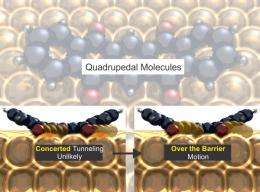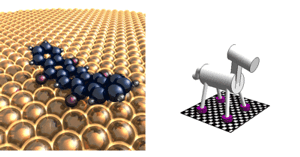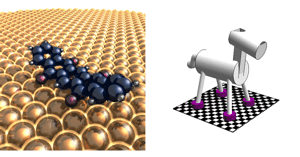Would a molecular horse trot, pace, or glide across a surface?

(PhysOrg.com) -- Ludwig Bartels's lab has studied a class of molecular machines that 'walk' across a flat metal surface in order to determine how a quadrupedal molecular machine would move.
Molecular machines can be found everywhere in nature, for example, transporting proteins through cells and aiding metabolism. To develop artificial molecular machines, scientists need to understand the rules that govern mechanics at the molecular or nanometer scale.
To address this challenge, a research team at the University of California, Riverside studied a class of molecular machines that ‘walk’ across a flat metal surface. They considered both bipedal machines that walk on two ‘legs’ and quadrupedal ones that walk on four.
“We made a horse-like structure with four ‘hooves’ to study how molecular machinery can organize the motion of multiple parts,” said Ludwig Bartels, a professor of chemistry, whose lab led the research. “A couple of years ago, we discovered how we can transport carbon dioxide molecules along a straight line across a surface using a molecular machine with two ‘feet’ that moved one step at a time. For the new research, we wanted to create a species that can carry more cargo - which means it would need more legs. But if a species has more than two legs, how will it organize their motion?”
-

Image shows a quadrupedal molecular machine using a pacing gait - both legs on one side of the molecule move together, followed next by the two legs on the opposite side of the molecule. Image credit: Bartels lab, UC Riverside. -

Image shows a quadrupedal molecular machine trotting - diagonally opposite hooves move together. The researchers found that this form of movement distorted the molecular species far too much to be viable. Image credit: Bartels lab, UC Riverside.
Bartels and colleagues performed experiments in the lab and found that the quadrupedal molecules use a pacing gait - both legs on one side of the molecule move together, followed next by the two legs on the opposite side of the molecule. The species they created moved reliably along a line, not rotating to the side or veering off course. The researchers also simulated a trotting of the species, in which diagonally opposite hooves move together, and found that this form of movement distorted the species far too much to be viable.
Having established how the molecule moves, the researchers next addressed a fundamental question about molecular machinery: Does a molecule - or portions of it - simply tunnel through barriers presented by the roughness it encounters along its path?
“If it did, this would be a fundamental departure from mechanics in the macroscopic world and would greatly speed up movement,” Bartels said. “It would be like driving on a bumpy road with the wheels of your car going through the bumps rather than over them. Quantum-mechanics is known to allow such behavior for very light particles like electrons and hydrogen atoms, but would it also be relevant for big molecules?”
Bartels and colleagues varied the temperature in their experiments to provide the molecular machines with different levels of energy, and studied how the speed of the machines varied as a consequence. They found that a machine with two legs can use tunneling to zip through the surface corrugation. But a machine with four (or potentially more) legs is not able to employ tunneling; while such a machine can coordinate the movement of its hooves in pacing, it cannot coordinate their tunneling, the researchers found.
“Thus, even at the tiniest scale, if you want to transport cargo fast, you need a light and nimble bipedal vehicle,” Bartels said. “Larger vehicles may be able to carry more cargo, but because they cannot use tunneling effectively, they end up having to move slowly. Is this discouraging? Not really, because molecular machinery as a concept is still in its infancy. Indeed, there is an advantage to having a molecule move slowly because it allows us to observe its movements more closely and learn how to control them.”
Study results appeared online last week in the Journal of the American Chemical Society, and will appear in print in an upcoming issue of the journal.
Next, the researchers plan to develop molecular machines whose motion can be controlled by light.
Currently, molecular machines are being studied intensely for their functions in biology and for their therapeutic value. For example, patients with GERD (Gastroesophageal reflux disease) are prescribed proton pump inhibitors, which slow the pumping action of biological molecular machines, thus reducing stomach acid levels.
“Generally, scientists’ picture of the working of such biological molecular machinery completely disregards tunneling,” Bartels said. “Our study corrects this perception, which may, in turn, lead to novel ways of controlling or correcting the behavior of biological molecular machines.”
Artificial molecular machines are of interest to the microelectronic industry in its quest for smaller and smaller active elements in computers and for data storage. Artificial molecular machines potentially can also operate inside cells like their biological counterparts, greatly benefiting medicine.
Bartels’s lab used the following molecules in the study: anthraquinone and pentaquinone (both bipedal); and pentacenetetrone and dimethyl pentacenetetrone (both quadrupedal).
The research was made possible by dedicated instrumentation developed and built in the Bartels lab. Bartels specializes in developing scanning tunneling microscopy instrumentation and applying it to molecular systems. Besides the Department of Chemistry, he holds appointments in the departments of physics, electrical engineering, mechanical engineering and the program in materials science and engineering.
Provided by University of California, Riverside















